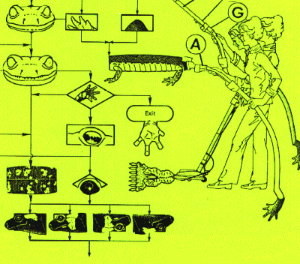
Hypertext as a term, was coined by Ted Nelson in 1965 in an attempt to describe a branching, non-sequential form of writing which could only exist within a computer environment. Nelson suffers from Attention Deficit Disorder which causes him to forget a train of thought if interrupted, and getting lost in a cascade of other associations. He invented the concept of hypertext as a memory strategy to keep track of his own thoughts.
When the idea of hypertext was translated on the Internet as the World Wide Web, by Tim Berners-Lee at CERN in 1989, hypertext links could include whole groups of other computers containing information distributed around the world. Any active point on the Web could interpenetrate another: an informational unit could link to any other anywhere in the world, while the perceived model for space and volume had become for all practical purposes, a union of opposites -- coinciding both in a point and in the infinite.
The World Wide Web is an abstraction of all the information sources which proceeded it. There is a current myth that depicts it as all-inclusive and that one day soon (if it hasn't happened already) we all will use it as a replacement of all these other informational sources. Clearly even at this early point in time, corporations and individuals who are trying to do business and who are not connected to the Internet, can no longer function. Like dinosaurs, those in such an environment have to 'evolve or die.' As with the shift from manuscript culture to print culture, the shift from print and video culture to hypertext culture is resulting in a basic change in human perception and structure of society.
That the hypertext format bears some vague surface resemblance to the techniques used by Renaissance magi, is perhaps a useful analogy. Certainly, the aggregation of images and points of view, have elucidated some sense of wonder among the netizens. One finds a plethora of Web pages which are comparable to the cabinets of wonder of the 16th century and are filled with all sorts of grotesquery. Here we might still be able to find the occasional two-headed frog, the stuffed Dodo, or a unicorn's horn: objects of such incomprehensible irrationality and vivid, repugnant beauty, that they take our breath away, spark the imagination, pulls us from our complacency, and bring us to the abyss of creativity. More than likely though, our wonder quickly fades to boredom, as self-discovery has become synonymous with self-advertisement on the Web. The only sense of wonder one may develop, is that when people are supposedly given a choice, how remarkably bad everything is.
Ironically, the Web as a device to focus one's attention has become something that is the complete opposite. It is a memory aid by which one can completely forget what they are looking for. Information in the electronic age, has become synonymous with entertainment, and much of the information that the Web contains is anecdotal, partial, and completely cranky. It's entertainment value is 'mildly diverting' and it has been described by the same old corundum used for TV: Why is there so many channels with nothing to watch except the same old thing over and over again? We have seen this rerun too many times before -- been there, done that!
Under the guise of integrating our knowledge resources, this technology continues to erode the distance between the senses, and we are further removed from the world which we live in. But one would like to think better of it. By releasing the written word from it's self-imposed linearity, a return to orality is imposed upon language along with its transfer of information. If Gutenberg's invention has frozen narrative into a linear, self-contained, multiple of itself, then the return to the unique, non-casual, non-sequential flow of ideas in orality can be seen as a way to get back to the gardens of expressiveness.
Linearity in thought is that aspect of human communication which has been excised, abstracted, domesticated and sanitized by the technology of media into what we believe is real. That which is outside the continuum is considered irrational. Our vestigial and amputated orality flops around like a paraplegic in attempting to expressed an anti-narrative. It haunts our dreams. It lurks within the structures of our myths. It is expansive, delusional, and self-articulating in ways that traditional narrative is linear, compact and succinct. It is a genealogy with a lot of pieces left out. With these fragments are endless redundancies within redundancies that leads to more redundancies. This is what 'channel surfing' and hypertext aspires to be. It is the mechanism of collage: the text, the movie and the video cut-up. It slices, dices, and sweeps the floor clean. It refines details with ever increasing speed, until they squeal. It is the sound that restarts the universe.